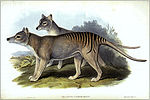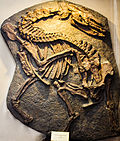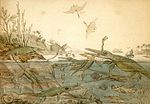Hyracotherium (/ˌhaɪrəkoʊˈθɪəriəm, -kə-/ HY-rək-o-THEER-ee-əm; "hyrax-like beast") is an extinct genus of very small (about 60 cm in length) perissodactyl...
7 KB (780 words) - 13:24, 16 June 2024
Eohippus (redirect from Hyracotherium vasacciensis)
only species is E. angustidens, which was long considered a species of Hyracotherium. Its remains have been identified in North America and date to the Early...
5 KB (452 words) - 19:12, 13 July 2024
Sifrhippus (redirect from Hyracotherium sandrae)
referred to in earlier literature as Hyracotherium sandrae, but Froehlich, arguing that the traditional genus Hyracotherium was not monophyletic, reassigned...
4 KB (383 words) - 12:47, 21 December 2023
Protorohippus (redirect from Hyracotherium vasacciense venticolum)
(Cope, 1881) †P. montanum Wortman, 18961 Synonyms Hyracotherium venticolum Cope, 1881 Hyracotherium vasacciense venticolum Kitts, 1956 Eohippus venticolum...
2 KB (85 words) - 12:47, 21 December 2023
present day. The earliest known member of the family Equidae was the Hyracotherium, which lived between 45 and 55 million years ago, during the Eocene...
141 KB (15,020 words) - 23:27, 30 August 2024
developed a hoof at this point, rather it still had pads as seen in Hyracotherium and Orohippus. The face of Mesohippus was longer and larger than earlier...
4 KB (348 words) - 05:52, 5 July 2024
different from Hyracotherium and a basal perissodactyl. It was later believed to be an equid and referred to Hyracotherium (Hyracotherium tapirinum, incl...
6 KB (708 words) - 18:39, 11 April 2024
pre-existing species. For example, it is sometimes claimed that the extinct Hyracotherium, which was an early horse that shares a common ancestor with the modern...
105 KB (11,165 words) - 22:19, 27 August 2024
early Eocene, 54 million years ago. They had been assigned to the genus Hyracotherium, but the type species of that genus is now considered not a member of...
59 KB (5,867 words) - 17:19, 21 August 2024
Eocene epoch, 54 million years ago. They were once assigned to the genus Hyracotherium, but the type species of that genus is now regarded as a palaeothere...
16 KB (1,433 words) - 21:35, 21 August 2024
bulkier version of its contemporary, the horse-like palaeothere Hyracotherium. Like Hyracotherium, it ate leaves and had five-toed front legs and three-toed...
2 KB (177 words) - 18:01, 11 April 2024
were a prominent feature of Eocene marine ecosystems. Moeritherium Hyracotherium Brontotherium Basilosaurus Andrewsarchus Borealosuchus Gastornis Pakicetus...
104 KB (11,561 words) - 19:32, 17 August 2024
Hippomorpha Family: †Palaeotheriidae Bonaparte, 1850 Genera Anchilophus Hyracotherium Idiodontherium Leptolophus Lijiangia Lophiotherium Pachynolophus Palaeotherium...
8 KB (716 words) - 07:34, 15 August 2024
zones. During the temporal unit, many genera of basal equoids such as Hyracotherium, Pliolophus, Cymbalophus, and Hallensia made their first appearances...
132 KB (14,847 words) - 04:09, 25 August 2024
new exhibit of fossil bones opened in 1957, and displayed fossils of Hyracotherium, a horse ancestor, and Coryphodon, a large hippo-like animal that lived...
53 KB (4,946 words) - 14:22, 5 August 2024
Biology, 1:139–185. MacFadden, B. J. 1986. Fossil horses from “Eohippus” (Hyracotherium) to Equus: scaling, Cope's Law, and the evolution of body size. Paleobiology...
8 KB (714 words) - 21:57, 2 May 2024
Pellucidarian equivalent are known. It first appeared in At the Earth's Core. Hyracotherium (Orthopi) — It first appeared in At the Earth's Core. Ichthyosaurus...
27 KB (3,281 words) - 15:56, 24 August 2024
(phylogeny). This evolutionary sequence starts with a small animal called Hyracotherium (commonly referred to as Eohippus), which lived in North America about...
245 KB (27,673 words) - 23:43, 26 August 2024
Allosaurus, Cynodont, Thrinaxodon, Eomaia, Carpolestes, Diatryma, Hyracotherium and Hyaenodontid. This episode chronicles primates that would evolve...
5 KB (451 words) - 18:39, 22 May 2024
55–45 Ma Early Eocene First creodonts. Earliest equid, Eohippus or Hyracotherium. First perching birds. First bats. The Andes begin to rise. Divergence...
237 KB (6,444 words) - 11:26, 30 August 2024
horse to illustrate this point, as the unbroken connection between Hyracotherium (formerly called Eohippus) and Equus provides an apparent linear path...
14 KB (1,794 words) - 13:10, 27 August 2024
that helped trace the evolution of the horse from the small 5-toed Hyracotherium of the Eocene to the much larger single-toed modern horses of the genus...
64 KB (8,410 words) - 07:57, 6 August 2024
Huerfano Formation Stratigraphic range: Paleogene Hyracotherium vasacciense (fossil horse) from the Huerfano Formation, Lower Eocene Type Formation Location...
2 KB (65 words) - 00:14, 24 August 2024
been preserved. For example, it is sometimes claimed that the extinct Hyracotherium (an ancient horse-like animal commonly known as an eohippus) is pseudoextinct...
12 KB (1,482 words) - 07:03, 26 April 2024
forming the earliest stages in the evolution of the horse, coming below Hyracotherium (see Equidae). As ancestors of the artiodactyl section of the Ungulata...
8 KB (771 words) - 07:01, 5 July 2024
Family Pachynolophidae Superfamily Equoidea Family Palaeotheriidae Genus Hyracotherium Genus Propalaeotherium Genus Palaeotherium Family Equidae Genus Miohippus...
183 KB (13,712 words) - 00:37, 10 May 2024
the lower San Jose Formation of the San Juan Basin. The presence of Hyracotherium teeth dates the formation to the late Paleocene or early Eocene. The...
4 KB (288 words) - 19:02, 13 July 2021
Caenolambda jepseni Coryphodon armatus Coryphodon sp. Perissodactyla Hyracotherium vasacciense Minippus index Placentalia Hyopsodus cf. wortmani Hyopsodus...
17 KB (239 words) - 21:49, 9 July 2024
it resembled other, basal forms of the order Perissodactyla, such as Hyracotherium or Sifrhippus, some of which were well-studied members of the early...
12 KB (1,357 words) - 09:18, 5 July 2024
Hemipristis †Hemisurcula †Hesperotestudo Heterodontus Hexaplex Hipponix Homo †Hyracotherium Isurus †Jefitchia Kellia Kuphus Laevicardium Lamna Latirus Lepisosteus...
29 KB (869 words) - 10:00, 12 June 2024
























